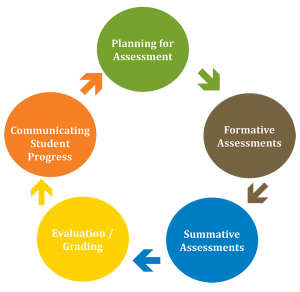
Principle #5
Students must be provided with ongoing feedback that is clear, specific, and timely to support their progress towards achieving learning goals.
“Feedback has no effect in a vacuum; to be powerful in its effect, there must be a learning context to which feedback is addressed.”
—Hattie and Timperley, 2007
Formative feedback is powerful in that it addresses both cognitive and motivational factors at the same time. Effective feedback from teachers has an effect size of 0.75 – a robust method of learning (Hattie). The impact of feedback on student achievement depends greatly on the timing, the type of feedback, and how it is delivered to students. Feedback is most meaningful to students while an assignment is fresh in their memory and while they are engaged in the learning process. Feedback is most beneficial to learning when it is descriptive, focused and directly connected to what students are learning. Meaningful, descriptive feedback gives students relevant information so they can understand where they are in their learning and what to do next. Quality feedback fosters a growth mindset in students, as it support students with a way to grow and improve, rather than highlighting their failures. It focuses on the assignment, not the student’s behaviours, efforts or attitude.
Descriptive Feedback:
- causes thinking
- provides detailed and specific information about learning and desired goals for improvement
- points out the strengths and weaknesses of the work
- addresses partial understanding
- does not do the thinking for students
- limits corrective information to the amount of advice the student can act on
(Chappuis, 2009)
ASSESSMENT CYCLE

TRY THIS
Click here for ideas to try in the classroom
1) Deconstruct the steps of the learning.
2) Use graphic organizers to help students organize their work. For example:
3) Use vertical learning tasks.
4) Adapt teaching so feedback can be given and incorporated.
5) Give feedback frequently.
6) Provide feedback immediately after an assessment.
7) Keep amount of feedback to a manageable amount:
- focus on only one or two aspects/criteria at a time
8) Give students the opportunity to redo/revise work.
9) Consider the effect of the words used in feedback on motivation and self-esteem.
10) Start feedback with something that is going well or something student has improved on – start with the strength.
WATCH THIS
Click here to watch related video content
Dylan Wiliam: Formative Assessment
Watch as Dylan Wiliam reviews the nature of formative assessment and how teachers can use it to gain better insights into student learning and achievement.
Carol Dweck, “Developing a Growth Mindset”
Should you tell your kids they are smart or talented? Professor Carol Dweck answers this question and more, as she talks about her groundbreaking work on developing mindsets. She emphasizes the power of “yet” in helping students succeed in and out of the classroom.
READ THIS
Click here for additional reading suggestions
To learn more, check out these texts:
- Berger, R., Rugen, L., & Woodfin, L. (2014). Leaders of their own learning: Transforming schools through student-engaged assessment. San Francisco, California. John Wiley and Sons, Inc.
- Brookhart, S. (2008). How to give effective feedback to your students. Alexandria, Virginia. Association for Supervision and Curriculum Development.
- Hattie, J., & Timperley, H. (2007). The power of feedback. Review of Educational Research, 77, 81-112.
- Moss, A., & Brookhart, S. (2009). Advancing formative assessment in every classroom: A guide for instructional leaders. Alexandria, Virginia. Association for Supervision and Curriculum Development.
- Ontario Ministry of Education. The Literacy and Numeracy Secretariat Capacity Building Series (2007). Retrieved at http://www.edu.gov.on.ca/eng/literacynumeracy/inspire/research/studentselfassessment.pdf.
- Ontario Ministry of Education. Growing Success. (2010). Retrieved at http://www.edu.gov.on.ca/eng/policyfunding/growSuccess.pdf.
- Western and Northern Canadian Protocol for Collaboration in Education. (2006). Rethinking Classroom Assessment with Purpose in Mind. Retrieved at https://www.wncp.ca/media/40539/rethink.pdf.
- Shepard, Lorrie A. “The Role of Assessment in a Learning Culture.” Educational Researcher 29, no. 7 (Oct 2000): 4:14.
